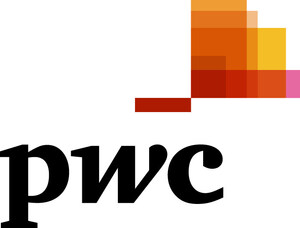NEW YORK, Feb. 10, 2011 /PRNewswire/ -- Merger and acquisition (M&A) deal activity in the global engineering and construction (E&C) sector showed continued improvement in Q4 2010, rising 39 percent in deal value and 47 percent in deal volume to $18.6 billion in 50 transactions (deals valued at $50 million or more), when compared to Q3 2010, according to the PwC US report, Engineering growth: Fourth-quarter 2010 global engineering & construction mergers and acquisitions analysis. Additionally, total annual deal volume increased from 139 in 2009 to 161 in 2010, while deal value increased from $42.1 billion in 2009 to $68.6 billion in 2010.
(Logo: http://photos.prnewswire.com/prnh/20100917/NY66894LOGO )
While mega-deal (transactions of $1 billion or more) activity was limited to just one deal in Q4, there were 12 mega-deals during all of 2010 compared with only six in 2009. This drove total mega-deal value to more than double from 2009, contributing to the overall increase in deal value. While mega-deal activity remains constrained compared to historical averages, the increase in mega-deals in 2010 is partly due to E&C companies' ability to raise capital.
"As expected, buyer activity continued building momentum as average deal values exceeded those in 2009," said Kent Goetjen, U.S. engineering and construction industry leader at PwC. "Interestingly, despite debt woes in Europe and persistent high levels of unemployment in the U.S., the engineering and construction sector remained optimistic."
Improving conditions have encouraged financial investors to return to the E&C deal environment after several quarters of declining participation. However, strategic investors continue to drive the majority of deals as they accounted for 73 percent of total deal activity in 2010, up from 67 percent in 2009. Although financial leverage has remained flat, cash on hand has increased, giving many E&C companies a strong position for future acquisitions.
From a regional perspective, Asia and Oceania continued to drive deal activity, accounting for 48 percent of deal volume in Q4. The Europe ex-UK & Eurozone region saw a significant decline in activity, decreasing to 4 percent in Q4 from 14 percent in Q3, while the UK & Eurozone region remained steady at 20 percent, despite recent concerns about economic recovery in the Eurozone. Meanwhile, the BRIC countries (Brazil, Russia, India, and China) continued to see an increase in deal activity, both for the quarter and the full year, with China continuing to generate the most activity.
During the fourth quarter of 2010, targets classified as construction and nonmetallic minerals manufacturing were the primary categories driving activity, contributing more than half of the quarter's deal volume. Although down from Q3, the home building category remained relatively strong, which may indicate buyers are positioning themselves for a potential increase in demand for residential real estate. There was an increase in civil engineering targets which may indicate buyers are also anticipating an increase in nonresidential and infrastructure construction.
Repositioning for Growth: The tax implications of expanding into a VISTA country
The fourth quarter Engineering growth report takes a close look at recent expansion into the VISTA (Vietnam, Indonesia, South Africa, Turkey, and Argentina) countries and the associated tax implications. Today's E&C companies have already found opportunities for growth through the establishment of operations in the BRIC countries. However, as companies seek to reposition their business strategy to meet new demands, they are now looking for new opportunities in a second wave of emerging markets, such as VISTA. When determining how and where to structure a deal, companies should consider the role tax could play in making or breaking the transaction.
In addition to their high gross domestic product (GDP) and rich natural resources, VISTA countries have favorable foreign investment policies. For instance, Indonesia, Vietnam, and Turkey implemented tax breaks for capital investments, subsidies for new businesses, and low-cost financing to attract new foreign business. Free trade zones, where normal trade barriers such as tariffs and quotas are eliminated and bureaucratic requirements are lowered in hopes of attracting investors from around the globe, are also common in the VISTA countries.
As BRIC countries continue to be saturated by multinational corporations, VISTA is an alternate option for consideration. While by comparison, China and Russia give the advantage to local businesses over outsiders, VISTA country governments view foreign investment as an important source of capital for their economies.
For information on Engineering growth and to access the full report, including the special section on the tax implications of expanding into a VISTA country, visit: http://www.pwc.com/us/industrialproducts.
About PwC's Global Engineering & Construction Practice
PwC's Engineering and Construction practice provides industry-focused assurance, tax, and advisory services. Through our global network, we can draw upon the in-depth industry experience of specialists in every country in which your company operates. Our people help our clients deal with the challenges of today, and they understand the implications for tomorrow.
About the PwC Network
PwC network firms provide industry-focused assurance, tax and advisory services to enhance value for their clients. More than 161,000 people in 154 countries across the PwC network share their thinking, experience and solutions to develop fresh perspectives and practical advice. See www.pwc.com for more information.
© 2011 PwC. All rights reserved. "PwC" and "PwC US" refers to PricewaterhouseCoopers LLP, a Delaware limited liability partnership, which is a member firm of PricewaterhouseCoopers International Limited, each member firm of which is a separate legal entity.
SOURCE PwC
WANT YOUR COMPANY'S NEWS FEATURED ON PRNEWSWIRE.COM?
Newsrooms &
Influencers
Digital Media
Outlets
Journalists
Opted In





Share this article